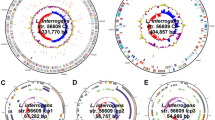Abstract
Spiroplasma citri was found to carry an 8.0 kb plasmid that differed from previously describedS. citri plasmids in its restriction map. It was also clonable in pBR322. The plasmid, named pRA1, was found in large quantities as free plasmid inS. citri (R8A2, Maroc) subclones of low passage level. In subclones of higher passage levels, free plasmid was replaced by plasmid sequences integrated into the spiroplasma chromosome. Significant quantities of integrated plasmid sequences were also observed in the corn stunt spiroplasma,S. kunkelii, while small quantities of free and/or integrated plasmid DNA could be detected in some spiroplasmas serologically and genotypically remote fromS. citri. Integrated plasmid sequences were cloned into theEscherichia coli plasmid pUC13. Hybridization tests and restriction maps of these clones indicated that the integrated plasmid sequences consisted of fragments, rather than entire plasmid DNA, inserted into specific sites in the spiroplasma chromosome. Although the biological role of the pRA1 plasmid remains unclear, theS. citri subclones containing large quantities of free plasmid exhibited slower growth rates and a tendency to lyse.
Similar content being viewed by others
Literature Cited
Archer DB, Best J, Barber C (1981) Isolation and restriction mapping of a spiroplasma plasmid. J Gen Microbiol 126:511–514
Barber CE, Archer DB, Daniels MJ (1983) Molecular biology of spiroplasma plasmids. Yale J Biol Med 56:777–781
Clewell DB, Helinski DR (1969) Supercoiled circular DNA-protein complex inEscherichia coli purification and induced conversion to an open circular DNA form. Proc. Natl Acad Sci USA 62:1159–1162
Cole RM (1979) Mycoplasma and spiroplasma viruses: ultrastructure. In: Barile MF, Razin S (eds) The mycoplasmas, vol 1. New York: Academic Press, pp 385–410
Dickinson MJ, Townsend R (1984) Characterization of the genome of a rod-shaped virus infectingSpiroplasma citri. J Gen Microbiol 65:1607–1610
Dickinson MJ, Townsend R (1984) The integration of a temperate phage infectingSpiroplasma citri. Isr J Med Sci 20:785–787
Dickinson MJ, Townsend R, Curson SJ (1984) Characterization of a virus infecting the wall-less prokaryoticSpiroplasma citri. Virology 135:524–535
Dybvig K, Maniloff J (1983) Integration and lysogeny by an enveloped mycoplasma virus. J Gen Virol 64:1781–1785
Grunstein M, Hogness D (1975) Colony hybridization: a method for the isolation of cloned DNAs that contain a specific gene. Proc Natl Acad Sci USA 72:3961–3965
Hartl DL, Dykhuizen DE, Miller RD, Green L, De Framond J (1983) Transposable element IS50 improves growth rate ofE. coli cells without transposition. Cell 35:503–510
Laemli UK (1970) Cleavage of structural proteins during the assembly of the head of bacteriophage T4. Nature 227:680–685
Marmur J (1961) A procedure for the isolation of deoxyribonucleic acid from microorganisms. J Mol Biol 3:208–218
Miller JH (ed) (1972) Experiments in molecular genetics. Cold Spring Harbor NY: Cold Spring Harbor Laboratory
Mouches C, Barroso G, Bove JM (1983) Characterization and molecular cloning inEscherichia coli of a plasmid from the mollicuteSpiroplasma citri. J Bacteriol 156:952–955
Mouches C, Barroso G, Gadeau A, Bove JM (1984) Characterization of two cryptic plasmids fromSpiroplasma citri and occurrence of their DNA sequences among various spiroplasmas. Ann Microbiol (Inst Pasteur) 135A:17–24
Nur I, Bove JM, Saillard C, Rottem S, Whitcomb RM, Razin S (1986) DNA probes in detection of spiroplasmas and mycoplasma-like organisms in plants and insects. FEMS Microbiol Lett 35:157–162
Ranhand JM, Mitchell WD, Popkin TJ, Cole RM (1980) Covalently closed circular deoxyribonucleic acids in spiroplasmas. J Bacteriol 143:1194–1199
Razin S, Gross M, Wormser M, Pollack Y, Glaser G (1984) Detection of mycoplasmas infecting cell cultures by DNA hybridization. In Vitro 20:404–408
Razin S, Hasin M, Ne'eman Z, Rottem S (1973) Isolation, chemical composition and ultrastructural features of the cell membrane of the mycoplasma-like organismSpiroplasma citri. J Bacteriol 116:1421–1435
Renaudin J, Pascarel MC, Garnier M, Carle P, Bove JM (1984) Characterization of spiroplasma virus 4 (SV4) Isr J Med Sci 20:797–799
Rigby PWJ, Duckman M, Rhodes C, Berg P (1977) Labeling deoxyribonucleic acid to a high specific activityin vitro by nick-translation with DNA polymerase I. J Mol Biol 113:237–251
Southern EM (1975) Detection of specific sequences among DNA fragments separated by gel electrophoresis. J Mol Biol 98:503–517
Townsend R (1983) Viruses ofSpiroplasma citri and their possible effects on pathogenicity. Yale J Biol Med 56:771–776
Vieira J, Messing JM (1982) The pUC plamids on M13mp7-derived system for insertion mutagenesis and sequencing with synthetic universal primers. Gene 19:159–268
Weinstock R, Sweet R, Weiss M, Cedar H, Axel R (1978) Intragenic DNA spacers interrupt the ovalbumin gene. Proc Natl Acad Sci USA 75:1299–1303
Whitcomb RF (1983) Culture media for spiroplasmas. In: Razin S, Tully JG (eds) Methods in mycoplasmology, vol 1. New York: Academic Press, pp 147–158
Author information
Authors and Affiliations
Rights and permissions
About this article
Cite this article
Nur, I., Glaser, G. & Razin, S. Free and integrated plasmid DNA in spiroplasmas. Current Microbiology 14, 169–176 (1986). https://doi.org/10.1007/BF01568370
Issue Date:
DOI: https://doi.org/10.1007/BF01568370




